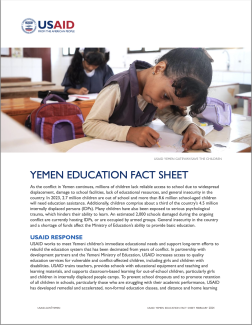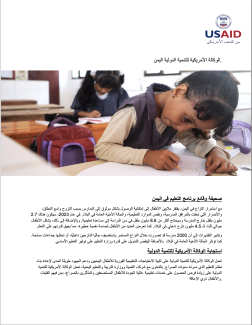As the conflict in Yemen continues, millions of children lack reliable access to school due to widespread displacement, damage to school facilities, lack of educational resources, and general insecurity in the country. In 2023, 2.7 million children are out of school and more than 8.6 million school-aged children will need education assistance. Additionally, children comprise about a third of the country’s 4.5 million internally displaced persons (IDPs). Many children have also been exposed to serious psychological trauma, which hinders their ability to learn. An estimated 2,000 schools damaged during the ongoing conflict are currently hosting IDPs, or are occupied by armed groups. General insecurity in the country and a shortage of funds affect the Ministry of Education’s ability to provide basic education.
USAID RESPONSE
USAID works to meet Yemeni children’s immediate educational needs and support long-term efforts to rebuild the education system that has been decimated from years of conflict. In partnership with development partners and the Yemeni Ministry of Education, USAID increases access to quality education services for vulnerable and conflict-affected children, including girls and children with disabilities. USAID trains teachers, provides schools with educational equipment and teaching and learning materials, and supports classroom-based learning for out-of-school children, particularly girls and children in internally displaced people camps. To prevent school dropouts and to promote retention of all children in schools, particularly those who are struggling with their academic performance, USAID has developed remedial and accelerated, non-formal education classes, and distance and home learning programs to support students whose schools closed due to insecurity, disease outbreaks, and climate shocks.
KEY RESULTS
- USAID education programs have provided child protection and water, sanitation, and hygiene activities to more than 275,000 Yemeni children across 676 formal and non-formal school settings.
- 522 father and mother councils (similar to parent teacher associations) and community education committees have mobilized more than 12,000 parents and community leaders to help keep children in school.
- Over 42,300 student kits and 2,800 kits for teachers have been distributed to promote an active learning environment. 2,235 teachers have improved their teaching skills and 446 school administrators received on the job training to improve school administration. More than 2,300 teachers were trained to provide psychosocial support to children in conflict affected areas.
- 910 children were screened for learning disabilities. Children with disabilities were provided assistive devices such as wheelchairs, hearing aids, and eyeglasses to continue their education. Training on sign language was provided to teachers to improve reading instruction.
- To mitigate the high risk of dropping out, 21,000 children were enrolled in accelerated and basic literacy and numeracy, non-formal education classes, and distance learning programs. Nearly 8,900 children were enrolled in remedial education programs to help them catch up from lost learning.
- Water and sanitation interventions benefitted an estimated 407,000 children and ensured that children, especially girls, had access to safe spaces to learn. USAID also worked to restore and rehabilitate schools and classrooms to increase the number of non-formal and remedial learning programs.
- Engaged over 5,100 teenagers and 11,000 community members through awareness raising and peer group activities to identify solutions to child protection risks and prevent abuses against children and adolescents, including child marriage and child recruitment into armed groups, and explain the positive benefits of education and staying in school.
- Piloted 50 girls clubs in schools to provide a safe environment for girls to express their concerns, exchange ideas, and inspire other girls to stay engaged with their education.
- Mentor teachers are working with school leadership in organizing and implementing extracurricular activities, creating opportunities for students to discuss concerns affecting their welfare such as early marriage, armed recruitment, and supporting literacy campaigns.
- USAID-supported students reported a 66 percent increase in literacy skills and 79 percent increase in numeracy skills from remedial classes. Developed literacy and numeracy textbooks, workbooks, and teacher guides with the Ministry of Education for Grades 1-3.


